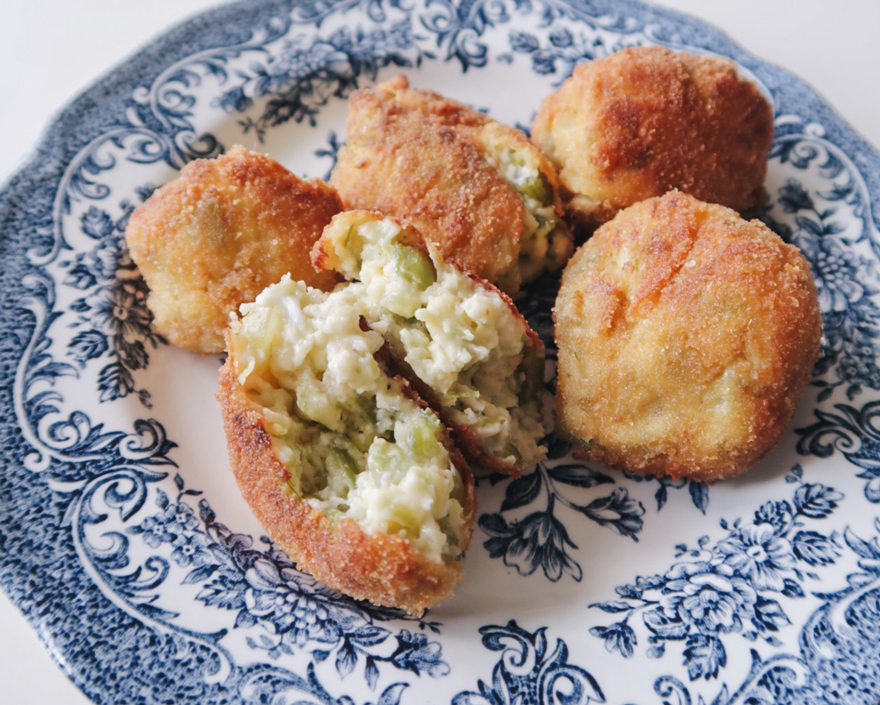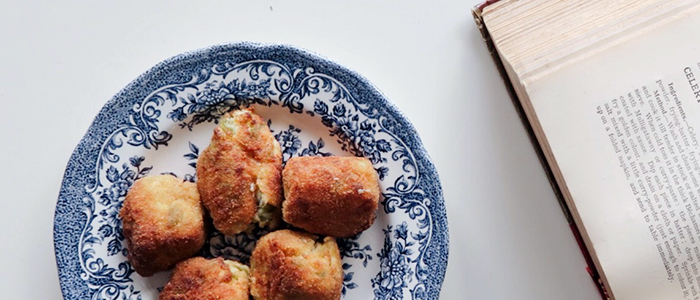Recently I thought it might be a fun quarantine project to revisit my copy of Mrs Beeton’s Household Management, c.1938, and make another historical recipe from the book. I narrowed it down to two that I thought would be fairly easy and interesting, and asked my Instagram followers to choose which one I should make – celery croquettes won out!

This book is one of my prized possessions. I’ve made a few recipes from Mrs Beeton before, but it’s been years since my last one.

Celery Croquettes – from Mrs Beeton’s Book of Household Management
Ingredients – 2 heads of celery, stock, 1 oz. of butter, 1 oz. of flour, 1 shallot, 1 gill of milk, seasoning, 1 egg, egg and breadcrumbs, fat for frying.
Method – Trim and wash the celery, and cut into short pieces, blanch them in salted water, and drain, then cook till tender in well-seasoned stock. Drain the cooked celery, and chop it rather finely. Melt the butter in a stewpan, add the shallot (chopped), and fry a little, stir in the flour, blend these together, and gradually add a gill of milk. Stir till it boils, and put in the chopped celery. Season with salt and pepper, and cook for 15 minutes, adding the egg last. Spread the mixture on a dish and let it get cold. Make up into croquettes – cork or ball shapes, egg and crumb them, fry in hot fat to a golden colour, drain them on a cloth or paper, and dish up.
Time – 1 hour. Sufficient for 6 to 7 persons.
I think this recipe ended up being the most complicated one I’ve done from Mrs Beeton so far! There was so much left unsaid. What is meant by “seasoning”? What are “short pieces” of celery? What the hell is a gill measurement?
I looked up the last one online, but was still a bit in the weeds for some of this recipe. Mrs Beeton was the first to present recipes in the standard structure we know today – Ingredients, method, time. Before that, recipes had no format, and could meander. You had to read the whole thing before you knew what ingredients to have and prepare. Yet despite Mrs Beeton’s familiar structure, I could have really used a little bit more detail, especially once it came to the butter-flour-milk-egg part.

What was the consistency supposed to be? Was it supposed to thicken? By how much? Should I stir it constantly, or let it sit? The recipe says to add the egg last, but how close to the end of the 15 minutes?

Still, despite my confusion about that whole section of the recipe, I think it turned out pretty well! I did end up somehow undercooking the mixture a little. Once I had them all ready and bit into one, I understood that I’d needed to either cook the mixture longer, or use less milk or something – because I didn’t know what the consistency needed to be and I was nervous of such a dry-looking mixture cooking for 15 minutes, I added more milk than the recipe called for.

Still, though, despite that, the flavour was quite nice!
Oh, and it did not take an hour – it was nearly twice that!

I know this book is intended for the female head of a household, who, it’s assumed, manages a staff including a cook. I think a recipe like this would have been given to the cook, who would have known instinctually the things I flailed to guess at. So I’m not too sad about nearly two hours spent at the stove on a 40C degree day, for a recipe that I ended up undercooking and not being able to eat more than a couple of bites of anyway.
Okay maybe I’m a little sad about it. But it was a fun quarantine activity, and I’m looking forward to my next Mrs Beeton recipe!

